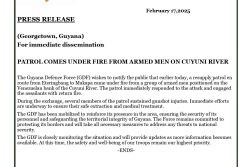Described by the US government as the leader of an extensive mortgage fraud scheme, New York-based Guyanese businessman Ed Ahmad could get a jail term of less than 6.5 to eight years when he comes up for sentencing on April 21 as prosecutors have asked for leniency because of his detailed testimony against former state senator John Sampson.
Following his arrest on July 21, 2011 in New York on a range of charges, Ahmed entered a plea agreement with the government and on October 13, 2012 pleaded guilty to bank and wire fraud conspiracy before Judge Dora Irizarry.
In its sentencing letter tendered to the judge on March 30, 2017, the US government also revealed that further wrongdoing on Ahmad’s part was discovered during his preparation for testimony against Sampson, a longtime friend of his. It is unclear what impact this might have on his sentencing.

There has been broad local interest in Ahmad’s case because of his ties to former President Bharrat Jagdeo.
According to the US court documents seen by Stabroek News, on June 22, 2015, shortly after he was to testify in the Sampson case, Ahmad disclosed that in order to secure his release, he had posted among other real estate, an encumbered commercial property. After he failed to make timely mortgage payments on the property following his arrest, the financial institution holding the mortgage accelerated the terms of repayment causing Ahmad to fear that the mortgage would go into default. Ahmad then borrowed US$60,000 from a business acquaintance to update his mortgage payments in return for a deed to the property.
“The defendant did not remove the property from the bond or otherwise inform Pre-Trial services, the Court, or the government before participating in this transaction, thus violating the terms of his bond. Subsequently, the financial institution continued to accelerate the default interest rate and consumed any remaining equity in the property. The business associate now owns the property”, the US sentencing letter stated.
Ahmad was further compromised by his testimony about his personal taxes, according to the sentencing letter.
“During his testimony on cross-examination, the defendant testified about his tax returns for 2006 and 2010, which reported income of approximately (US)$51,000 and (US)$23,300 in income, respectively. However, during his initial appearance after his arrest in this matter in 2011, the defendant reported to the magistrate judge that he earned approximately (US)$150,000 per year during each of the prior two years. During Sampson’s trial, the defendant testified that his accountant prepared the defendant’s tax returns based on truthful information previously provided by the defendant, and that the defendant did not presently recall the content of the tax returns”, the sentencing letter stated.
Notwithstanding these “critical lapses” in judgement by Ahmad, the US sentencing letter said that the jury ultimately credited the government’s evidence in finding Sampson guilty on three charges and the same Judge Irizarry sentenced Sampson to five years of incarceration for each charge to run concurrently.
“…the defendant (Ahmad) provided substantial assistance to the government. For these reasons, the government respectfully moves pursuant to Section 5K1.1 of the United States Sentencing Guidelines to permit the Court, in its discretion, to sentence the defendant below the applicable Guidelines range”, the sentencing letter said.
Falsifying
The US sentencing letter provided detailed information on the mortgage fraud scheme which ensnared Ahmad.
It said that beginning in 2000, Ahmad and other co-conspirators defrauded various lending institutions by acquiring mortgages on properties in the Eastern District of New York and elsewhere through fraudulent means, including by falsifying mortgage loan applications. That bogus information made the borrowers appear to be more creditworthy. As a result, the financial institutions were fraudulently induced to issue mortgages secured by the properties. “In some instances, the co-conspirators recruited individuals (the “Straw Buyers”) to conceal the true ownership of the Properties. The Straw Buyers posed as the purchasers of Properties, which, in reality, were controlled by other co-conspirators. In other instances, the co-conspirators recruited prospective home purchasers with good credit scores but with income and assets that were insufficient to secure mortgage loans (the “Purchasers”) to purchase Properties. Though the Purchasers intended to purchase and take possession of the Properties, the co-conspirators arranged for some of the Purchasers to enter into mortgage loans that the Purchasers could not afford.
“Once Straw Buyers or Purchasers were recruited, the coconspirators prepared mortgage applications for the Properties that contained numerous misrepresentations and falsehoods designed to make the Straw Buyers or Purchasers appear to be more creditworthy. Among other things, the mortgage applications falsely inflated bank account balances and income for Straw Buyers and Purchasers. In addition, the mortgage applications for the Straw Buyers falsely stated that the Straw Buyers would live at the Properties”, the US sentencing letter related. As a condition for issuing the mortgages, the financial institutions required Straw Buyers and Purchasers to make down payments on the purchase of the properties, and limited the amount that the co-conspirators could receive as real estate commissions and fees. Notwith-standing the requirements, the Straw Buyers and Purchasers often did not make any down payments, and the co-conspirators kept commissions and fees in excess of those permitted by the financial institutions.
“To conceal these facts from the lenders, members of the conspiracy falsified Department of Housing and Urban Development (HUD) forms in order to deceive the lenders about disbursements at closings. For example, the Falsified HUD Forms represented that some of the Purchasers or Straw Buyers had made a down payment or other cash payment to the sellers when, in fact, none had been made. The Falsified HUD Forms also understated the co-conspirators’ true loan fees and real estate commissions, which, unbeknownst to the Lenders, exceeded the thresholds they permitted”, the US sentencing letter stated.
“The defendant was the leader of this extensive mortgage fraud scheme. At all relevant times, the defendant owned and operated a real estate business and a mortgage brokerage, through which businesses mortgage loans were disbursed on the basis of materially false information. In furtherance of the scheme, the defendant directed his employees to inflate the Purchasers’ income information on mortgage applications to increase the likelihood of approval by the Lenders. The defendant also directed his employees to falsify employment information regarding the Purchasers by listing local businesses as employers on the loan applications. The defendant paid local businesses to verify the Purchasers’ employment with the Lenders. Additionally, the defendant himself purchased Properties through the use of Straw Buyers, including his own wife, for investment purposes. Finally, the defendant charged mortgage commissions well in excess of rates allowed by the Lenders. He caused closing attorneys, who were coconspirators in the mortgage fraud scheme, to conceal the excessive commissions through Falsified HUD Forms that were submitted to the Lenders”, the US sentencing letter stated.
Ahmad participated in or caused numerous closings involving properties. The US sentencing letter cited 163 properties in 2006 and 2007 alone—many of which resulted in losses suffered by the lenders. The total loss amount to financial institutions is US$3,007,573.
“The defendant’s criminal activity had a particularly pernicious effect on families who lost their homes to foreclosure and the community at large which was blighted by foreclosed properties”, the sentencing letter stated..
The US sentencing letter attached a proposed restitution form for the defendant’s sentencing saying that he has joint and several liability for the US$3.007m lost by various financial institutions.
These are Countrywide Home Loans/Bank of America to the tune of US$1.043m, Freemont Investment for US$778,841, Option One Mortgage Corporation US$169,719, Wells Fargo Home Mortgage, US$253,020, Decision One Mortgage/HSBC Mortgage, US$112,360, Ocwen, US$190,290, Argent Mortgage/Citibank, US$230,000 and New Century/Deutsche Bank, US$230,000.
The US sentencing letter further pointed out that as part of the defendant’s cooperation agreement, he agreed to pay US$500,000 before the date of his sentencing. To date, the defendant has made a partial payment of US$29,662.18.
Sentencing of Ahmad was deferred 10 times. He was originally supposed to be sentenced on January 15th, 2016.
The judge on the last occasion said that she had reluctantly granted another delay and upbraided the US government for not providing its sentencing letter. She ordered that it be presented on March 24. It was finally presented on March 30th. The defendant’s sentencing submission has to be presented by April 7th.







